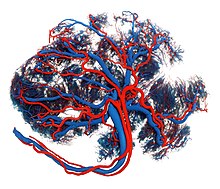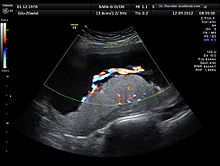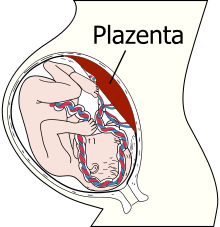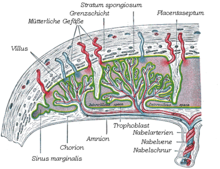Placenta
![]()
This article describes the placenta in vertebrates; for the placenta in plants, see Placenta (botany).
![]()
Placenta is a redirect to this article. For other meanings, see Placenta (disambiguation).
The placenta (Latin placenta 'cake', also placenta or 'fruit cake') is a tissue on the uterine wall that develops during pregnancy in all higher female mammals (Eutheria), including humans and some marsupials (Metatheria). It belongs to the embryonic organism, is formed by it and is interwoven with blood vessels of the mother and the embryo. Through it, the embryo (later the fetus) is indirectly connected to the mother's bloodstream, receives nutrients and oxygen, and releases waste products. After delivery, the placenta is expelled together with the egg skin as afterbirth. An analogous structure is represented by the yolk sac placenta of the basal sharks, which, like the placenta of mammals, serves to supply the embryos.

human placenta, plastinate

Ultrasound image of the placenta and umbilical cord with color Doppler imaging of the three umbilical vessels, at 20 weeks of gestation.

Human placenta with fetus

Placenta in the human body
Functions
The placenta consists of both embryonic and maternal tissue. The placenta is formed when embryonic tissue grows into the endometrium or decidua. It ensures the supply of nutrients, the disposal of excretory products and the gas exchange of the embryo or fetus. The connection between the embryo and the placenta is made via the umbilical cord.
Unlike all other human organs, which only begin to function after a sufficient period of development and maturation, the placenta must control its own growth and develop full functionality in parallel. At each stage of pregnancy, the specific needs of the child must be met. In addition to caring for the child, the placenta fulfils hormonal tasks. The ability of the placenta to influence the mother's immune system in such a way that it remains functional and thus protects the mother from infections, but at the same time is prevented from rejecting the placenta itself and the child as foreign tissue, has hardly been researched yet.
Structure
In its mature state, the human placenta is an organ weighing approximately 500 to 600 grams and measuring 15 to 20 centimetres in diameter, which forms after the blastocyst has implanted (nidation) in the uterus. It develops from the fetal trophoblast and from the maternal endometrium. The fetal side of the placenta - i.e. the chorionic plate and umbilical cord - is covered with whitish opaque amniotic epithelium (see last picture). Between the chorionic plate and the maternal basal plate (decidua) is the intervillous space filled with maternal blood. This is divided by connective tissue placental septa from the basal plate into 15 to 20 fields called cotyledons. Primary villi, which carry the secondary villi, grow from the chorion into these blood-filled cotyledons. By sprouting capillaries, the secondary villus becomes the tertiary villus and is thus ready to exchange substances. (In the figure, the entire villus tree is referred to as the villus.) No blood exchange takes place between the capillaries of the tertiary villi and the intervillous space because of the placental barrier (see below). Substance exchange occurs by diffusion, facilitated diffusion, pinocytosis, or is mediated by receptors. From the fourth week of pregnancy, when the baby's heart begins to beat, the fruit is supplied via the placenta.
As an organ, the placenta serves only a limited time. It is characterized by the lowest content of tight connective tissue of all organs. In addition, the placenta is not permeated with nerves.

Schematic structure of the placenta
_180_Mutterkuchen.png)
Schematic structure
Questions and Answers
Q: What is the placenta?
A: The placenta is a temporary organ in the uterus (womb) of pregnant female mammals.
Q: What are the main roles of the placenta?
A: The main roles of the placenta are to transfer oxygen and nutrients from the mother's blood to the baby's blood, and to transfer waste molecules back from the baby's blood to the mother's. It also protects the baby from harmful substances in the mother's blood, and produces hormones that support the pregnancy.
Q: How is it connected to both mother and baby?
A: The placenta is attached to wall of uterus and connected to baby by big blood vessels in umbilical cord.
Q: What happens after birth?
A: After birth, both placenta and umbilical cord are pushed out of uterus. At this time they are often called afterbirth.
Q: Does it have any other functions besides transferring oxygen and nutrients?
A: Yes, it also protects baby from harmful substances in mother’s blood, as well as produces hormones that support pregnancy.
Q: Is there anything else that comes out with it when it leaves after birth?
A: Yes, when it leaves after birth its accompanied by umbilical cord which was connecting them together before birth.
Q: What do people call these two things together once they leave after birth? A: People usually refer them as "afterbirth" when they leave afterbirth together.
Search within the encyclopedia